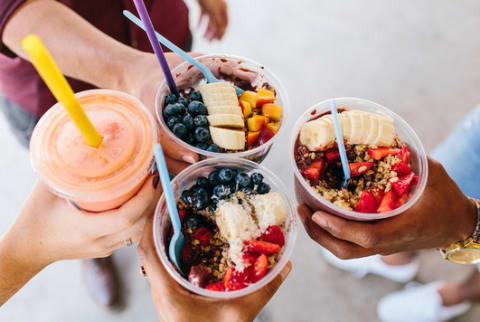Advertisement


Whether it's your favorite meal of the day or the one you care about the least, breakfast is your chance to front-load your system with the vitamins and nutrients you need to power through the day. Do it wrong, however, and you'll be a nutritionally compromised zombie — sleepy, hungry, moody, and ill-equipped to tackle the day.
And, unfortunately, most people are doing it wrong, filling up on junky, low-fuel, high-sugar breakfasts that give rise to hunger pangs, mood swings, and cravings before they even get to the office.
Sound familiar? Don't worry. I've put together a list of the most common breakfast mistakes to avoid — plus a bunch of energizing, healthy breakfast solutions to start your day off right:
1. Choosing "healthy" cereal.
Just about every person over the age of 10 knows that Lucky Charms makes a lousy breakfast — but what about the healthier-sounding ones like granola, muesli, or All-Bran?
Sorry, cereal lovers, they're not much better. Most of these options are packed with sugar and carbs and come up short on protein and healthy fats. The result? Most people wind up feeling hungry soon after eating them. Adding insult to injury, most cereals are made from genetically modified crops that have been treated with pesticides and include preservatives like endocrine-disrupting BHT and suspected carcinogen BHA. My advice? Don't fill your belly with this crap.
2. Drinking bottled juices for breakfast.
I'm a big proponent of cleanses and detoxes — done right — but I'm not a big fan of bottled juice cleanses because most provide little (if any) fat, fiber, or protein to fill you up. Even the ones that may have valuable nutrients deliver a big dose of sugar, which means blood sugar and insulin spikes. Another cause for concern? Consumers assume their bottled, "healthy" pressed juices contain just one serving when more often than not, they contain two servings. The upshot? When people drink a full bottle, they're taking in twice as much sugar — anywhere from 20 to 30 grams.
3. Opting for the classics.
You may not want to hear this, but traditional pancakes are, in no uncertain terms, a nutritional nightmare. We're talking a perfect storm of genetically modified ingredients, sugar, refined carbs, gluten, factory-farmed eggs, and milk — all topped with a healthy dose of maple-brown-tinted high-fructose corn syrup. Virtually devoid of protein, fiber, or good fats, this nutrition-free carb-bomb is the reason you're starving, lethargic, and cranky an hour or so after eating a stack. Even as a special treat, pancakes are a bad, energy-sapping breakfast idea, so grow up, and let 'em go.
4. Buying a muffin on-the-go.
If you pit the average homemade muffin against the massive ones on sale at your local breakfast or coffee place, you can't help but notice the David vs. Goliath disparity. The ingredients are problematic too: sugar, refined flours, trans fats, genetically modified ingredients, pesticides, preservatives, etc., and barely a scrap of anything nutritious. Think of the average store-bought muffin as essentially a giant piece of unfrosted birthday cake — hardly an energizing way to start the day.
What to eat instead for a better breakfast:
OK, so once you take pancakes, muffins, cereal, and juices off the menu, you may be wondering, "What in the world am I going to eat for breakfast?!" Glad you asked because at Be Well, we have tons of ideas on how to build amazing and energizing breakfasts. Here are seven options — a week’s worth of breakfast meals! — to get you started on the better breakfast path:
1. Paleo egg "muffins"
Make a dozen of these at a time and freeze for a delicious, portable breakfast anytime. Pack two "muffins" in a travel container; add some greens, black beans, and sliced avocado in another; and you're out the door. At the office, warm the muffins in the microwave for 30 seconds and voilà, breakfast is served.
2. Luscious leftovers to go
If dinner was great last night, why not enjoy it again in the morning? Toss last night's roasted vegetables into an omelet, poach two organic eggs and serve atop leftover sautéed greens, or chop up leftover baked sweet potato and use in a veggie-filled hash — the possibilities are endless! Now that your new and improved breakfast menu doesn't include sugar and dough, there's lots more room for tasty, nutritious, real food.
3. Open-faced, gluten-free power "sandwich"
If it's just not breakfast without toast, then make this Paleo bread recipe. Toast up a slice or two and top with one of these combos (or create your own):
- Sweet: nut butter and strawberry slices, plus a sprinkle of chia seeds
- Savory: mashed avocado on toast, topped with shredded chicken, salmon, or sardines
4. Smoothies
Yes, our team here at Be Well is, admittedly, a little crazy for smoothies as long as they are not sugar bombs. We are constantly discovering delicious new variations; this Mocha Choca Smoothie is my current favorite.
5. Paleo "pancakes"
Still craving pancakes? Then give your mom's recipe a modern, healthy makeover. Whip up a batch of high-protein "pancakes" made with coconut flour, mashed bananas, and eggs.
6. Chocolate chia seed pudding
Who said a healthy breakfast can't also feel like a treat? You can make a big batch of chocolate chia seed pudding, and it will keep in the fridge for up to three days. Here's the recipe:
- 2 tablespoons chia seeds
- 1 cup of your favorite nondairy milk (almond, cashew or coconut are great)
- 1 tablespoon raw cacao powder
- 1 teaspoon cinnamon
- A squirt of raw honey (adjust to suit your sweet tooth)
- A sprinkle of sea salt
Place all ingredients in a sealed jar and shake. Refrigerate for 10 to 15 minutes, and dig in!
7. Toad in the hole
The kiddie version involves an egg and toast. The exquisitely delicious, nutritious grown-up version keeps the egg but trades the toast for half an acorn squash garnished with chives. Bake it the night before to save precious morning minutes — and allow you more time to eat and savor!

For Dr. Frank Lipman, health is more than just the absence of disease: it is a total state of physical, mental, emotional, spiritual and social wellbeing. Dr. Lipman is a widely recognized trailblazer and leader in functional and integrative medicine, and he is a New York Times best-selling author of five books, How to Be Well, The New Health Rules, Young and Slim for Life, Revive and Total Renewal.
After his initial medical training in his native South Africa, Lipman spent 18 months working at clinics in the bush. He became familiar with the local traditional healers, called sangomas, which kindled his interest in non-Western healing modalities
In 1984, Lipman immigrated to the United States, where he became the chief medical resident at Lincoln Hospital in Bronx, NY. While there, he became fascinated by the hospital’s addiction clinic, which used acupuncture and Chinese medicine making him even more aware of the potential of implementing non-Western medicine to promote holistic wellbeing.
He began studying nutrition, acupuncture, Chinese medicine, herbal medicine, functional medicine, biofeedback, meditation, and yoga. Lipman founded the Eleven Eleven Wellness Center in 1992, where he combines the best of Western medicine and cutting edge nutritional science with age-old healing techniques from the East. As his patient, chef Seamus Mullen, told The New York Times, “If antibiotics are right, he’ll try it. If it’s an anti-inflammatory diet, he’ll do that. He’s looking at the body as a system rather than looking at isolated things.”
In addition to his practice, he is also an instructor in mbg's Functional Nutrition Program.
More from the author:
Functional Nutrition Training
Check out Functional Nutrition Coaching
A cutting-edge nutrition deep dive taught by 20+ top health & wellness experts
Learn moreMore from the author:
Functional Nutrition Training
Check out Functional Nutrition Coaching
A cutting-edge nutrition deep dive taught by 20+ top health & wellness experts
Learn more
For Dr. Frank Lipman, health is more than just the absence of disease: it is a total state of physical, mental, emotional, spiritual and social wellbeing. Dr. Lipman is a widely recognized trailblazer and leader in functional and integrative medicine, and he is a New York Times best-selling author of five books, How to Be Well, The New Health Rules, Young and Slim for Life, Revive and Total Renewal.
After his initial medical training in his native South Africa, Lipman spent 18 months working at clinics in the bush. He became familiar with the local traditional healers, called sangomas, which kindled his interest in non-Western healing modalities
In 1984, Lipman immigrated to the United States, where he became the chief medical resident at Lincoln Hospital in Bronx, NY. While there, he became fascinated by the hospital’s addiction clinic, which used acupuncture and Chinese medicine making him even more aware of the potential of implementing non-Western medicine to promote holistic wellbeing.
He began studying nutrition, acupuncture, Chinese medicine, herbal medicine, functional medicine, biofeedback, meditation, and yoga. Lipman founded the Eleven Eleven Wellness Center in 1992, where he combines the best of Western medicine and cutting edge nutritional science with age-old healing techniques from the East. As his patient, chef Seamus Mullen, told The New York Times, “If antibiotics are right, he’ll try it. If it’s an anti-inflammatory diet, he’ll do that. He’s looking at the body as a system rather than looking at isolated things.”
In addition to his practice, he is also an instructor in mbg's Functional Nutrition Program.
Watch Next
Enjoy some of our favorite clips from classes
Enjoy some of our favorite clips from classes
What Is Meditation?
Mindfulness/Spirituality | Light Watkins
Box Breathing
Mindfulness/Spirituality | Gwen Dittmar
What Breathwork Can Address
Mindfulness/Spirituality | Gwen Dittmar
The 8 Limbs of Yoga - What is Asana?
Yoga | Caley Alyssa
Two Standing Postures to Open Up Tight Hips
Yoga | Caley Alyssa
How Plants Can Optimize Athletic Performance
Nutrition | Rich Roll
What to Eat Before a Workout
Nutrition | Rich Roll
How Ayurveda Helps Us Navigate Modern Life
Nutrition | Sahara Rose
Messages About Love & Relationships
Love & Relationships | Esther Perel
Love Languages
Love & Relationships | Esther Perel

















